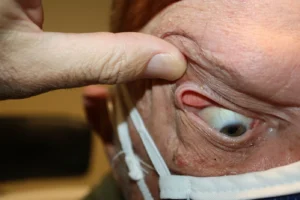Floppy eyelid is a condition with a decrease in the number of elastin fibers in the tarsus, the dense connective tissue that forms the structure of the eyelids. This leads to a loose, rubbery, tarsus and eyelids that can be easily flipped over. The eyelid flips during sleep and rubs against the pillow, leading to an irritated eye with frequent discharge. Patients with floppy eyelid also commonly have lash ptosis, where the lashes point in a downward direction and block the vision, and lid ptosis. Correction of the floppy eyelid often but not always fixes these secondary problems. There is a high association between floppy eyelid syndrome and sleep apnea. If you are diagnosed with floppy eyelid syndrome it is very important to get tested for sleep apnea, as patients with untreated sleep apnea have an increased risk of heart attack and death.
Correction of floppy eyelid syndrome involves removing a large portion of the tarsus and a smaller portion of the overlying skin. By creating skin flaps in the upper lid, Dr. Hellman can remove larger portions of tarsus than he could if he simply excised a wedge of eyelid tissue, a procedure commonly used to treat floppy eyelid syndrome. This helps prevent recurrence of the condition after surgery.
